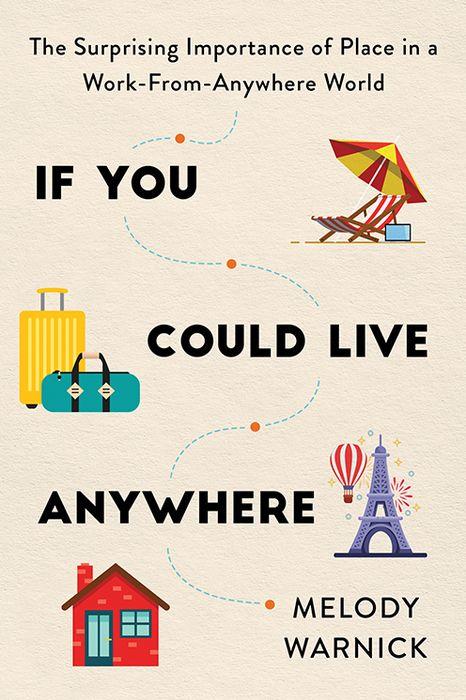If You Could Live Anywhere by Melody Warnick – A Must Read for Economic Developers

If you could live anywhere, where would you live? That question used to fall into the same category as “what would you do if you won the lottery?” or “if you could have dinner with anyone, living or dead, who would it be?” A nice ice-breaker type of question, something we all dream about but don’t expect to come true. However, the reality is that for many Americans, the ability to choose to live anywhere they want isn’t just a daydream anymore, thanks in part to a changing work environment. That’s why we chose Melody Warnick’s new book, If You Could Live Anywhere, as the conference book for the Women’s Economic Development Network 2023 forum.
The way we work has changed, and the COVID-19 pandemic only helped improve the flexibility of work situations for many Americans. An estimated 35% of the American workforce freelances, according to Upwork’s 2020 report. Add to that the growing number of people who are able to work from home, thanks to always improving technology and flexible work environments, as well as the ever-present group of entrepreneurs looking for locations to start a business, and the number of flexible workers grows even larger. So if you don’t have to live where you work, where do you live?
Melody Warnick helps answer that question in If You Could Live Anywhere. Her book serves not only as a guide to anywhereists, a term she coined to encompass that group of flexible workers, digital nomads and retirees, but it also helps leaders of cities and towns get a peek into what factors into the decision of where to live when work is no longer a deciding factor.
If You Could Live Anywhere serves as a natural follow-up to Warnick’s first book, This is Where You Belong (our WEDN book in 2018). In that book she dove deep into place attachment to find out what makes Americans put down roots and truly settle into a place. In her latest book she takes that a step further to help readers do the work to find that place.
It all starts with intensive self-examination. Just as companies outline a location strategy when opening new locations or building a headquarters, individuals should create parameters to narrow down options of where to live. In order to make that location strategy, Warnick provides lists of questions and exercises to help people understand their own motivations and fine tune the factors driving their location search. Researching the basics such as cost of living, school quality and internet access fall alongside exercises that encourage the reader to examine their values and weigh the importance of other factors such as spirituality, creativity, and engagement opportunities.
Armed with a knowledge of what shapes a person’s location search, Warnick created a list of location strategy values. She dives deep into the different location strategy values, dedicating a chapter to each one to fully describe them with great stories of real people and their experiences.
- Recognition
- Wealth
- Entrepreneurship
- Connection
- Creativity
- Adventure
- Learning
- Purpose
- Happiness
Living in a place where you can get more for your money plays a big role in anywhereists location decisions. Beyond affordable housing, people also look for towns that allow them to go out to eat and enjoy activities without stretching their budget. Having money to invest in retirement accounts or a new business venture also adds to the attraction of a lower cost of living.
However, money isn’t the only factor in location strategy values. People are looking for communities that provide avenues to network with other business owners and entrepreneurs, as well as opportunities to meet new people and build friendships. Places that put emphasis on fostering creativity and value learning tend to rise to the top during an anywherists’ decision making processes.
Determining the weight of each location strategy value has a lot to do with the type of anywhereist making those decisions. Warnick defines three categories of anywhereists:
Seekers: People who put a lot of research, time and effort into choosing the “just right” place to move, and possible even go through this process multiple times until they feel they’ve found the perfect place.
Wanderers: People who love the nomadic lifestyle, and move from place to place to experience new adventures. They might be better defined as everywhereists rather than anywhereists.
Settlers: People who move to a place where they want to put down roots and make it their new home.
For economic developers, city planners and anyone hoping to make their place attractive to anywhereists, Warnick’s book provides a plethora of ideas to attract all three of these categories of people. Highlighting outdoor activities such as whitewater rafting or rock climbing might pull in the wanderers and seekers looking for adventure in their next location, while co-work space and new business attraction programs attract settlers looking to start their own business or work with others to get creative juices flowing. Providing financial incentives to make your location stand out in anywhereists’ searches can be similar to tax breaks used to lure new companies, and Warnick provides examples such as Remote Shoals and Tulsa Remote, which offered $10,000 for people to relocate.
In the end, the ultimate goal is to find a place that makes you happy. For those who proudly answer “I’d live right here” to the question of where you would live if you could live anywhere, Warnick’s book provides a roadmap to understanding what it is about your place that makes it your personal anywhere. Armed with that knowledge, you can help share the benefits and advantages with others, and attract anywhereists to come enjoy the place where you live.